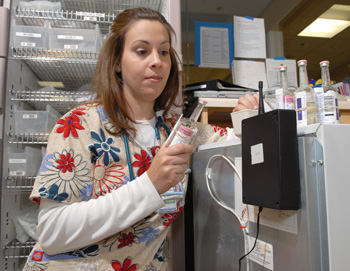
Kimberly Barnes, R.N., checks the radio frequency temperature sensing device on a refrigerator at the Monroe Carell Jr. Children’s Hospital at Vanderbilt. (photo by Neil Brake)
Radio frequency devices tuning up staff efficiency
A device a bit smaller than an average box of tissues could help staff at the Monroe Carell Jr. Children's Hospital at Vanderbilt create more time to care for patients.
The device uses radio frequency (RF) technology to monitor routine equipment to make sure it's running properly, a task normally handled manually by staff throughout the hospital.
At Children's Hospital, the first things to be hooked up to RF temperature-monitoring devices were more than 220 refrigerators.
RF boxes work by monitoring the unit's temperature and sending a regularly pulsed radio frequency signal back to a central computer database. One person can sign on to the computer system and read the temperature of any refrigerator anywhere in the hospital without having to physically check them.
“It's important for any problem with a temperature change to be caught quickly because if a refrigerator stops working properly, you can lose several batches of important food supplements or medicines,” said Barbara Joers, associate director of hospital operations at Children's Hospital.
“It used to be that staff on each floor, usually a charge nurse or medical receptionist, would have to go and check a temperature gauge inside a refrigerator at regular intervals, but with RF, they would only be tasked with checking on problems when the devices signal the need.”
The RF system is designed to send alerts to staff when there is a problem. If a unit on a particular floor is beginning to malfunction, a staff member can be automatically paged to call for service, check on the unit, or move medications until the problem can be fixed.
Checking individual refrigerator units is a non-patient oriented task that can add to a staff member's already busy day. A system like this can be installed for about $150,000 and theoretically improve the accuracy of checks and speed fixes, while allowing staff to spend more time with patient and family needs.
The next item to be considered for Children's Hospital RF devices are warming units.
“The more we can use technology to do basic, non-patient care activities, the better service we can provide. Staff will have more time to focus on their primary mission — our patients,” said Joers.













